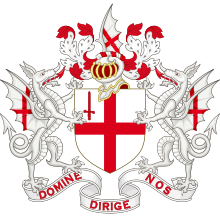
The City of London, widely referred to simply as the City, is a city, ceremonial county and local government district that contains the ancient centre, and constitutes, along with Canary Wharf, the primary central business district (CBD) of London and one of the leading financial centres of the world. It constituted most of London from its settlement by the Romans in the 1st century AD to the Middle Ages, but the modern area referred to as London has since grown far beyond the City of London boundary. The City is now only a small part of the metropolis of Greater London, though it remains a notable part of central London. The City of London is not one of the London boroughs, a status reserved for the other 32 districts. It is also a separate ceremonial county, being an enclave surrounded by Greater London, and is the smallest ceremonial county in England.

The European dragon is a legendary creature in folklore and mythology among the overlapping cultures of Europe.

Cavendish is a village and civil parish in the Stour Valley in Suffolk, England.

Simon Sudbury was Bishop of London from 1361 to 1375, Archbishop of Canterbury from 1375 until his death, and in the last year of his life Lord Chancellor of England. He met a violent death during the Peasants' Revolt in 1381.

The flag of England is the national flag of England, a constituent country of the United Kingdom. It is derived from Saint George's Cross. The association of the red cross as an emblem of England can be traced back to the Late Middle Ages when it was gradually, increasingly, used alongside the Royal Banner. It became the only saint's flag permitted to be flown in public as part of the English Reformation and at a similar time became the pre-eminent maritime flag referred to as a white ensign. It was used as a component in the design of the Union Jack in 1606.

In heraldry, Saint George's Cross is a red cross on a white background, which from the Late Middle Ages became associated with Saint George, the military saint, often depicted as a crusader.
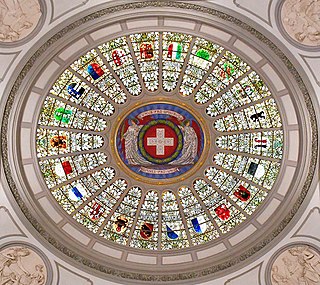
Each of the 26 modern cantons of Switzerland has an official flag and a coat of arms. The history of development of these designs spans the 13th to the 20th centuries.
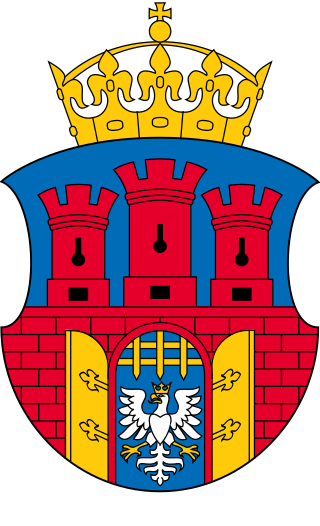
The city of Kraków uses a coat of arms, a seal, official colors, a flag, and a banner as its official symbols. Additionally, a number of semi-official and unofficial symbols of the city are also used.
The baselard, Schwiizerdolch in Swiss-German is a historical type of dagger or short sword of the Late Middle Ages.

Sir William Walworth was an English nobleman and politician who was twice Lord Mayor of London. He is best known for killing Wat Tyler during the Peasants' Revolt in 1381.

The coat of arms of Scotland, colloquially called the Lion Rampant, is the coat of arms historically used as arms of dominion by the monarchs of the Kingdom of Scotland, and later by monarchs of Great Britain and the United Kingdom. The coat of arms, or elements from it, are also used in heraldry to symbolise Scotland in general. The arms consist of a red lion surrounded by a red double border decorated with fleurs-de-lis, all on a gold background. The blazon, or heraldic description, is: Or a lion rampant Gules armed and langued Azure within a double tressure flory-counter-flory of the second.

The coat of arms of the City of York Council is the coat of arms granted to the City of York Council, the local authority of the City of York, England. The borough has been extended a number of times from the original city contained within the city walls. However, the arms have remained the same throughout all these changes to the borough.

Giltspur Street is a street in Smithfield in the City of London, England, running north–south from the junction of Newgate Street, Holborn Viaduct and Old Bailey, up to West Smithfield, and it is bounded to the east by St Bartholomew's Hospital. It was formerly known as Knightsriders Street, from the knights riding at the tournaments in Smithfield.
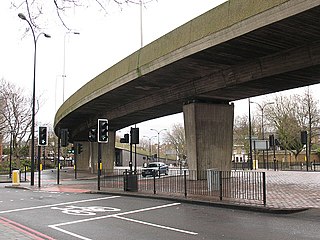
Bricklayers Arms is the road intersection of the A2 and the London Inner Ring Road where Bermondsey meets Walworth and Elephant & Castle in south London. It is the junction of Tower Bridge Road, Old Kent Road, New Kent Road and Great Dover Street. It comprises a four-way green roundabout plus one-way flyover and one-way bypass lane.

Fishmongers' Hall is a Grade II* listed building adjacent to London Bridge. It is the headquarters of the Worshipful Company of Fishmongers, one of the 111 livery companies of the City of London. The Hall is situated in Bridge Ward.
Sir Nicholas Brembre was a wealthy magnate and a chief ally of King Richard II in 14th-century England. He was Lord Mayor of London in 1377, and again from 1384–5,6. Named a "worthie and puissant man of the city" by Richard Grafton, he became a citizen and grocer of London, and in 1372-3 purchased from the Malmains family the estates of Mereworth, Maplescomb, and West Peckham, in Kent. His ties to Richard ultimately resulted in his downfall, as the anti-Richard Lords Appellant effectively took control of the government and imprisoned, exiled, or executed most of Richard's court. Despite Richard's efforts, Brembre was executed in 1388 for treason at the behest of the Lords Appellant.

The Lion of Saint Mark, representing Mark the Evangelist, pictured in the form of a winged lion, is an aspect of the Tetramorph. On the pinnacle of St Mark's Cathedral he is depicted as holding a Bible, and surmounting a golden lion which is the symbol of the city of Venice and formerly of the Venetian Republic.

The dragon boundary marks are cast iron statues of dragons on metal or stone plinths that mark the boundaries of the City of London. The dragons are painted silver, with details of their wings and tongue picked out in red. The dragon stands on its left rear leg, with the right rear leg lifted forward to support a shield, with the right foreleg raised and the left foreleg holding the top of the shield. The shield bears the City of London's coat of arms painted in red and white: the red cross of St George on a white background, with a red sword in the first quarter referring to the reputed beheading of Saint Paul. Saint George and Saint Paul are respectively the patron saints of England and of London. The dragon's stance is the equivalent of the rampant heraldic attitude of the supporters of the City's arms, which may allude to the legend of Saint George and the Dragon.
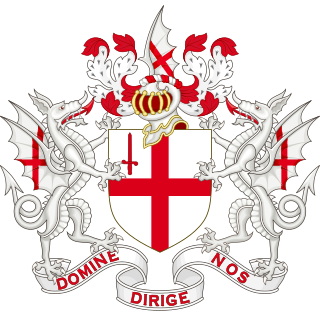
The coat of arms of the City of London Corporation is the official coat of arms granted to the City of London Corporation. The Corporation governs the City of London, one of the 33 administrative areas within Greater London, England.


